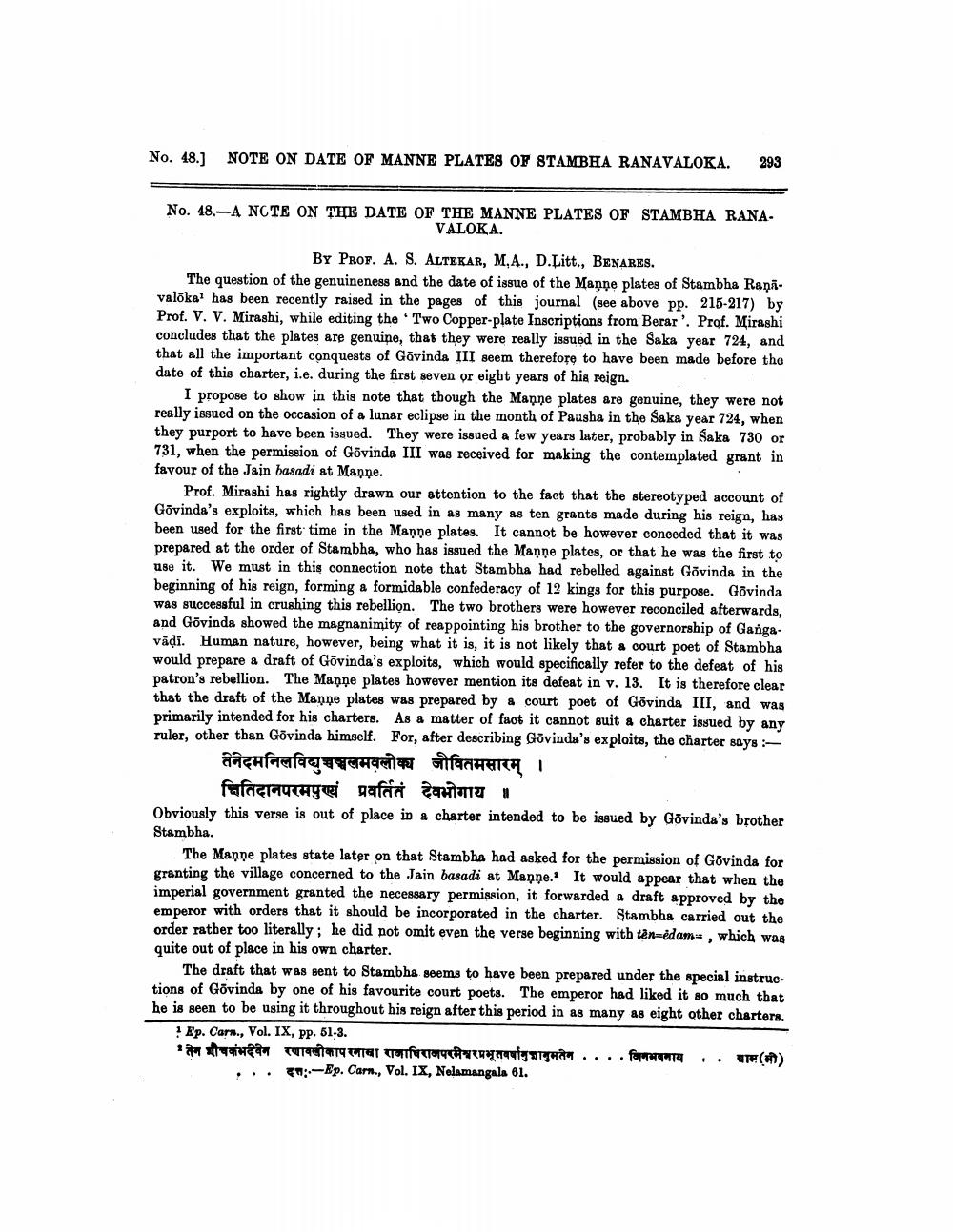________________
No. 48.) NOTE ON DATE OF MANNE PLATES OF STAMBHA RANAVALOKA.
293
No. 48.-A NCTE ON THE DATE OF THE MANNE PLATES OF STAMBHA RANA.
VALOKA.
BY PROF. A. S. ALTEKAR, M,A., D.Litt., BENARES. The question of the genuineness and the date of issue of the Maņne plates of Stambha Raņāvalókat has been recently raised in the pages of this journal (see above pp. 215-217) by Prof. V. V. Mirashi, while editing the Two Copper-plate Inscriptions from Berar'. Prof. Mirashi concludes that the plates are genuine, that they were really issued in the Saka year 724, and that all the important conquests of Govinda III seem therefore to have been made before the date of this charter, i.e. during the first seven or eight years of his reign.
I propose to show in this note that though the Manne plates are genuine, they were not really issued on the occasion of a lunar eclipse in the month of Pausha in the Saka year 724, when they purport to have been issued. They were issued a few years later, probably in Saka 730 or 731, when the permission of Govinda III was received for making the contemplated grant in favour of the Jain basadi at Manne.
Prof. Mirashi has rightly drawn our attention to the fact that the stereotyped account of Govinda's exploits, which has been used in as many as ten grants made during his reign, has been used for the first time in the Manne plates. It cannot be however conceded that it was prepared at the order of Stambha, who has issued the Manne plates, or that he was the first to use it. We must in this connection note that Stambha had rebelled against Govinda in the beginning of his reign, forming a formidable confederacy of 12 kings for this purpose. Govinda was successful in crushing this rebellion. The two brothers were however reconciled afterwards, and Govinda showed the magnanimity of reappointing his brother to the governorship of Gangavādi. Human nature, however, being what it is, it is not likely that a court poet of Stambha would prepare a draft of Govinda's exploits, which would specifically refer to the defeat of his patron's rebellion. The Manne plates however mention its defeat in v. 13. It is therefore clear that the draft of the Manne plates was prepared by a court poet of Govinda III, and was primarily intended for his charters. As a matter of faot it cannot suit a charter issued by any ruler, other than Govinda himself. For, after describing Govinda's exploits, the charter says:
तेनेदमनिलविद्युच्चञ्चलमवलोक्य जीवितमसारम् ।
चितिदानपरमपुण्यं प्रवर्तितं देवभोगाय । Obviously this verse is out of place in a charter intended to be issued by Govinda's brother Stambha.
The Manne plates state later on that Stambha had asked for the permission of Govinda for granting the village concerned to the Jain basadi at Mapne. It would appear that when the imperial government granted the necessary permission, it forwarded a draft approved by the emperor with orders that it should be incorporated in the charter. Stambha carried out the order rather too literally; he did not omit even the verse beginning with tên=ėdam= , which was quite out of place in his own charter.
The draft that was sent to Stambha seems to have been prepared under the special instructions of Govinda by one of his favourite court poets. The emperor had liked it so much that he is seen to be using it throughout his reign after this period in as many as eight other charters.
! Ep. Carn., Vol. IX, pp. 51-3. ** han rettet rolifecam y wigan.... foramra . ()
... 49:-Ep. Carn., Vol. IX, Nelamangala 61.




